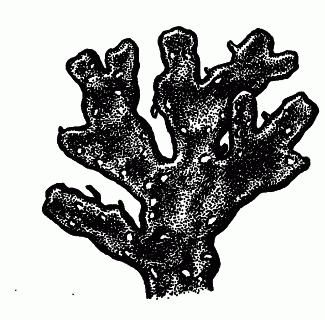Melanelia stygia (L.) Essl.
Durable rockleather
Parmeliaceae
Introduction to the Lichens
Durable rockleather
Parmeliaceae
Introduction to the Lichens
Map
Distribution of Melanelia stygia unavailable
Species Information
General:
Common Name: The Brown Lichens. Describes the colour of the upper surface in this genus. Small to occasionally medium stratified foliose lichens, corticate above and below, sorediate or isidiate or not, pseudocyphellate or not, lobes closely appressed to rather loosely appressed, short to elongate, 0.4–4 (–7) mm wide, thin or somtimes rather thick. Upper surface brown, K-, HNO3- (ours), pruinose or not. Lower surface pale to blackish, bearing short, simple rhizines. Medulla white. Photobiont green.
Apothecia located over upper surface, disc brown; spores simple, ellipsoid, colourless, 8 (–32) per ascus.
Over bark or rock.
Notes: Melanelia is primarily a temperate and boreal genus consisting of about 35 species worldwide. Twentythree of these occur in North America and 17 in B.C. Melanelia was one of several genera recently segregated from the classic genus Parmelia.
Species description:
Soredia and isidia absent (Note: low, white-tipped conical warts/papillae may develop over upper surface of some species) AND
Over rock or (rarely) soil AND
Melanelia stygia), distribution various AND
Pseudocyphellae and pycnidia absent or, if present, then scattered over upper surface, pycnidia either somewhat sunken or at most slightly protruding above upper cortex AND
Upper surface brownish or blackish throughout, K-, never white-pruinose; pseudocyphellae, when present, spot-like or at least not elongate-angular; medulla K- AND
Pseudocyphellae distinct over upper surface (check in vicinity of lobe tips) AND
Lower surface blackening (check toward thallus centre); medulla KC+ reddish or PD+ strong orange AND
Rhizines essentially restricted to margins of lower surface; medulla KC-, PD+ strong orange
OR
Soredia and isidia absent (Note: low, white-tipped conical warts/papillae may develop over upper surface of some species) AND
Over rock or (rarely) soil AND
Melanelia stygia), distribution various AND
Pseudocyphellae and pycnidia absent or, if present, then scattered over upper surface, pycnidia either somewhat sunken or at most slightly protruding above upper cortex AND
Upper surface brownish or blackish throughout, K-, never white-pruinose; pseudocyphellae, when present, spot-like or at least not elongate-angular; medulla K- AND
Pseudocyphellae distinct over upper surface (check in vicinity of lobe tips) AND
Lower surface primarily pale brown to medium brown (or black in localized areas); medulla KC- or KC+ pale orangish, PD-. AND
Lobes strongly convex; pseudocyphellae averaging to less than 0.2 mm long; medulla KC-
Comments:
The material assigned to this species is morphologically diverse and may represent two or more taxa.
Reactions:
Medulla PD+ orangish or PD
Contents:
(Caperatic, fumarprotocetraric and protocetraric acids and various unknown substances; occasionally lacking lichen substances.)
Source: Lichens of British Columbia
Illustration

If more than one illustration is available for a species (e.g., separate illustrations were provided for two subspecies) then links to the separate images will be provided below. Note that individual subspecies or varietal illustrations are not always available.
Illustration By: Trevor Goward
Habitat and Range
Habitat: Frequent over acid rock in open inland sitesWorld Distribution: circumpolar, S to WA.
Source: Lichens of British Columbia
Status Information
Synonyms
Synonyms and Alternate Names:
Parmelia stygia (L.) Ach.